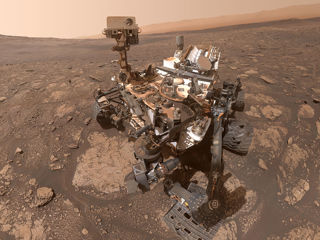
Curiosity Rover: 10 Years on Mars
- 4th Aug 2022
- Author: Ed Kellond-Turner
Mission Aims
Curiosity had several aims when sent to Mars, the first of which was completed as the rover successfully touched down. NASA wanted to demonstrate the ability to land a very large, heavy rover with a high degree of accuracy, opening the door to similar missions in the future, such as the more recent Perseverance Rover.
Curiosity’s scientific goals can be categorised into four main groups:
- Determine whether life ever arose on Mars.
- Study the climate of Mars.
- Study the geology of Mars.
- Assess the surface radiation.
These goals are closely interlinked and were further broken down by NASA to help Curiosity meet these targets. They include studying organic carbon compounds, interpreting the processes that formed and changed rocks and soils, determining the cycle of water and carbon dioxide, and characterising the surface radiation levels.
Scientific Equipment
Curiosity has several instruments aboard that aid in its scientific exploration of Mars. One such experiment fires neutrons at the Martian surface, which slow down when coming into contact with hydrogen atoms, which is an excellent indicator for water.
It has three cameras aboard, which together have taken thousands of detailed close-up photos of Martian rock samples, as well as some of the amazing pictures seen in this blog. NASA used one of these cameras to take the first selfie on a different planet.
The rover is also equipped with a drill which can bore holes 6.5 centimetres into the Martian soil and rock, allowing sample collection and study. Curiosity can take these soil samples and vaporise them, analysing the gases produced to gain an insight into how those samples were formed.
Mission Outcomes
The first of Curiosity’s discoveries was found just after the rover landed. Curiosity found rounded pebbles that had been smoothed and eroded by persistent liquid water in Mars’ past. This finding was supported by a sample taken in Yellowknife Bay, which revealed clay minerals with minimal salt, suggesting fresh, drinkable water had once flowed there. This sample also showed sulphur, nitrogen, oxygen, phosphorus, and carbon, which are all key ingredients for life.
Curiosity also discovered an atmosphere with active methane, increasing ten-fold over a two-month period. This is exciting as methane can be produced by chemical reactions between water and rock or by living organisms!
Another of Curiosity’s key findings was the level of radiation, both in deep space on the way to Mars, and on the surface. The amount of radiation would pose huge health risks to astronauts if left unshielded, so NASA will use this data to design missions that keep any humans safe.
Curiosity has made many discoveries that scientists are still trying to get their heads around. As it continues to roam around it will keep discovering new mysteries for scientists to unfold in the coming years.
Recently scientists have been able to explain how Tridymite (a rare type of quartz) that was discovered by Curiosity in 2016 might have come to be. Tridymite is usually linked to explosive and evolved volcanic systems on Earth, but it was found at the bottom of an ancient lake on Mars (Gale Crater), where most of the volcanoes are very young.
The scientists suggest that the Martian magma lay in a chamber below a volcano for longer than usual allowing it to partially cool and form into the silicon concentrated quartz – tridymite. Then a massive explosive eruption was able to spew that tridymite into the lake that would eventually become Gale Carter.
This means Mars would’ve had explosive volcanism more than 3 billion years ago, at a time when Mars was becoming dry and barren compared to the wet and warm planet it once was. Mars is likely to have an intriguing volcanic past – more exciting than we might have considered before Curiosity.
Even with a new rover, Perseverance, on the scene, Curiosity continues to soldier on, collecting data and sending its findings back to Earth. Curiosity still has a long way to beat the record for longest operational lifespan for a Mars rover (set at 14 years and 136 days by the Opportunity rover), so it will be interesting to see what this rover achieves in the coming years.
Full image credits / references
(Banner image)Curiosity Looking Dusty on the Surface of Mars. Credit: NASA/JPL-Caltech/MSSS
(1) Curiosity Landing Under the Sky Crane. Credit: NASA/JPL-Caltech
(2) Scientific Equipment Aboard Curiosity. Credit: NASA/JPL-Caltech
(3a) 'Cumberland' Target Drilled by Curiosity. Credit: NASA/JPL-Caltech/MSSS
(3b) Remnants of an Ancient Streambed on Mars. Credit: NASA/JPL-Caltech/MSSS
(4) Mars, with Olympus Mons Seen in the Centre of the Planet. Credit: NASA/JPL-Caltech/University of Arizona






